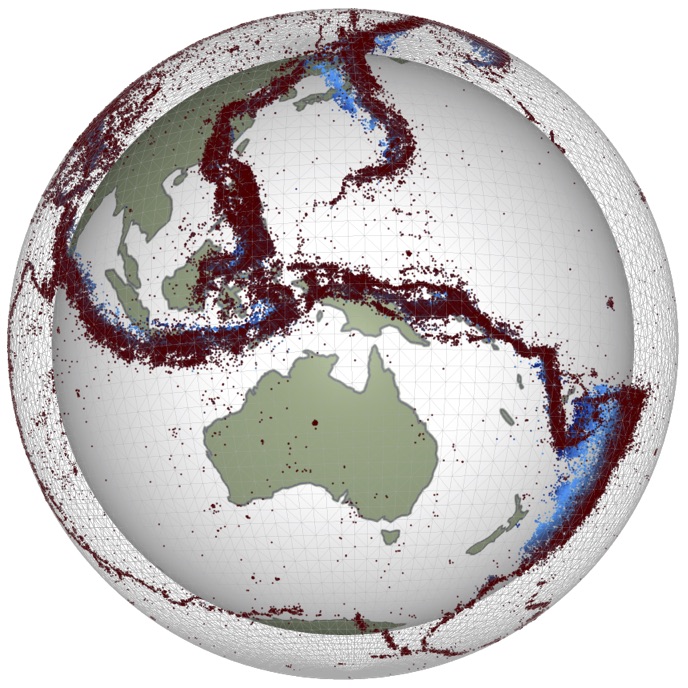Constant viscosity convection, Cartesian domain (benchmark)#
This is a simple example in which we try to instantiate two solvers on the mesh and have them use a common set of variables.
We set up a v, p, T system in which we will solve for a steady-state T field in response to thermal boundary conditions and then use the steady-state T field to compute a stokes flow in response.
The next step is to add particles at node points and sample back along the streamlines to find values of the T field at a previous time.
(Note, we keep all the pieces from previous increments of this problem to ensure that we don’t break something along the way)
# to fix trame issue
import nest_asyncio
nest_asyncio.apply()
import petsc4py
from petsc4py import PETSc
import underworld3 as uw
from underworld3.systems import Stokes
from underworld3 import function
import numpy as np
import sympy
meshbox = uw.meshing.UnstructuredSimplexBox(
minCoords=(0.0, 0.0),
maxCoords=(1.0, 1.0),
cellSize=1.0 / 32.0,
regular=False,
qdegree=3,
)
# check the mesh if in a notebook / serial
if uw.mpi.size == 1:
import pyvista as pv
import underworld3.visualisation as vis
# pv.start_xvfb()
pvmesh = vis.mesh_to_pv_mesh(meshbox)
pl = pv.Plotter(window_size=(1000, 750))
# pl.add_mesh(pvmesh,'Black', 'wireframe', opacity=0.5)
pl.add_mesh(pvmesh, edge_color="Black", show_edges=True)
pl.show(cpos="xy")
v_soln = uw.discretisation.MeshVariable("U", meshbox, meshbox.dim, degree=2)
p_soln = uw.discretisation.MeshVariable("P", meshbox, 1, degree=1)
t_soln = uw.discretisation.MeshVariable("T", meshbox, 1, degree=3)
t_0 = uw.discretisation.MeshVariable("T0", meshbox, 1, degree=3)
# Create Stokes object
stokes = Stokes(
meshbox,
velocityField=v_soln,
pressureField=p_soln,
solver_name="stokes",
)
# Constant viscosity
viscosity = 1
stokes.constitutive_model = uw.constitutive_models.ViscousFlowModel
stokes.constitutive_model.Parameters.shear_viscosity_0 = 1.0
stokes.tolerance = 1.0e-3
# free slip.
# note with petsc we always need to provide a vector of correct cardinality.
stokes.add_dirichlet_bc((sympy.oo,0.0), "Bottom")
stokes.add_dirichlet_bc((sympy.oo, 0.0), "Top")
stokes.add_dirichlet_bc((0.0,sympy.oo), "Left")
stokes.add_dirichlet_bc((0.0,sympy.oo), "Right")
# Create a density structure / buoyancy force
# gravity will vary linearly from zero at the centre
# of the sphere to (say) 1 at the surface
import sympy
# Some useful coordinate stuff
x, y = meshbox.X
# Create adv_diff object
# Set some things
k = 1.0
h = 0.0
adv_diff = uw.systems.AdvDiffusionSLCN(
meshbox,
u_Field=t_soln,
V_fn=v_soln,
solver_name="adv_diff",
)
adv_diff.constitutive_model = uw.constitutive_models.DiffusionModel
adv_diff.constitutive_model.Parameters.diffusivity = k
adv_diff.theta = 0.5
# Define T boundary conditions via a sympy function
import sympy
init_t = 0.01 * sympy.sin(5.0 * x) * sympy.sin(np.pi * y) + (1.0 - y)
adv_diff.add_dirichlet_bc(1.0, "Bottom")
adv_diff.add_dirichlet_bc(0.0, "Top")
with meshbox.access(t_0, t_soln):
t_0.data[...] = uw.function.evaluate(init_t, t_0.coords, meshbox.N).reshape(-1, 1)
t_soln.data[...] = t_0.data[...]
buoyancy_force = 1.0e6 * t_soln.sym[0]
stokes.bodyforce = sympy.Matrix([0, buoyancy_force])
# check the stokes solve is set up and that it converges
stokes.solve(zero_init_guess=True)
# Check the diffusion part of the solve converges
adv_diff.solve(timestep=0.1 * stokes.estimate_dt(), zero_init_guess=True)
# check the mesh if in a notebook / serial
if uw.mpi.size == 1:
import pyvista as pv
import underworld3.visualisation as vis
pvmesh = vis.mesh_to_pv_mesh(meshbox)
pvmesh.point_data["V"] = vis.vector_fn_to_pv_points(pvmesh, v_soln.sym)/10
pvmesh.point_data["T"] = vis.scalar_fn_to_pv_points(pvmesh, t_soln.sym)
points = vis.meshVariable_to_pv_cloud(t_soln)
point_cloud = pv.PolyData(points)
point_cloud.point_data["Tp"] = vis.scalar_fn_to_pv_points(points, t_soln.sym)
# points = np.zeros((t_soln.coords.shape[0], 3))
# points[:, 0] = t_soln.coords[:, 0]
# points[:, 1] = t_soln.coords[:, 1]
# point_cloud = pv.PolyData(points)
# with meshbox.access():
# point_cloud.point_data["Tp"] = t_soln.data.copy()
# point sources at cell centres
cpoints = np.zeros((meshbox._centroids.shape[0] // 4, 3))
cpoints[:, 0] = meshbox._centroids[::4, 0]
cpoints[:, 1] = meshbox._centroids[::4, 1]
cpoint_cloud = pv.PolyData(cpoints)
pvstream = pvmesh.streamlines_from_source(
cpoint_cloud,
vectors="V",
integrator_type=2,
integration_direction="forward",
compute_vorticity=False,
max_steps=1000,
surface_streamlines=True,
)
pl = pv.Plotter(window_size=(1000, 750))
# pl.add_mesh(pvmesh,'Gray', 'wireframe')
# pl.add_mesh(
# pvmesh, cmap="coolwarm", edge_color="Black",
# show_edges=True, scalars="T", use_transparency=False, opacity=0.5,
# )
pl.add_points(
point_cloud,
cmap="coolwarm",
render_points_as_spheres=True,
point_size=10,
opacity=0.33,
)
pl.add_mesh(pvstream, opacity=0.5)
# pl.add_arrows(arrow_loc2, arrow_length2, mag=1.0e-1)
# pl.add_points(pdata)
pl.show(cpos="xy")
pvmesh.clear_data()
pvmesh.clear_point_data()
pvmesh.clear_point_data()
def plot_T_mesh(filename):
if uw.mpi.size == 1:
import pyvista as pv
import underworld3.visualisation as vis
pvmesh = vis.mesh_to_pv_mesh(meshbox)
pvmesh.point_data["V"] = vis.vector_fn_to_pv_points(pvmesh, v_soln.sym)/333
pvmesh.point_data["T"] = vis.scalar_fn_to_pv_points(pvmesh, t_soln.sym)
# point sources at cell centres
cpoints = np.zeros((meshbox._centroids.shape[0] // 4, 3))
cpoints[:, 0] = meshbox._centroids[::4, 0]
cpoints[:, 1] = meshbox._centroids[::4, 1]
cpoint_cloud = pv.PolyData(cpoints)
pvstream = pvmesh.streamlines_from_source(
cpoint_cloud,
vectors="V",
integrator_type=45,
integration_direction="forward",
compute_vorticity=False,
max_steps=25,
surface_streamlines=True,
)
points = vis.meshVariable_to_pv_cloud(t_soln)
points.point_data["T"] = vis.scalar_fn_to_pv_points(points, t_soln.sym)
point_cloud = pv.PolyData(points)
pl = pv.Plotter(window_size=(1000, 750))
pl.add_mesh(
pvmesh,
cmap="coolwarm",
edge_color="Gray",
show_edges=True,
scalars="T",
use_transparency=False,
opacity=0.5,
)
pl.add_points(
point_cloud,
cmap="coolwarm",
render_points_as_spheres=False,
point_size=10,
opacity=0.5,
)
pl.add_mesh(pvstream, opacity=0.4)
pl.remove_scalar_bar("T")
pl.remove_scalar_bar("V")
pl.screenshot(
filename="{}.png".format(filename),
window_size=(1280, 1280),
return_img=False,
)
# pl.show()
pl.close()
pvmesh.clear_data()
pvmesh.clear_point_data()
pv.close_all()
t_step = 0
# Convection model / update in time
##
## There is a strange interaction here between the solvers if the zero_guess is
## set to False
##
expt_name = "output/Ra1e6"
for step in range(0, 50):
stokes.solve(zero_init_guess=True)
delta_t = 5.0 * stokes.estimate_dt()
adv_diff.solve(timestep=delta_t, zero_init_guess=False)
# stats then loop
tstats = t_soln.stats()
if uw.mpi.rank == 0:
print("Timestep {}, dt {}".format(step, delta_t))
# print(tstats)
if t_step % 5 == 0:
plot_T_mesh(filename="{}_step_{}".format(expt_name, t_step))
t_step += 1
savefile = “output_conv/convection_cylinder.h5”.format(step) meshbox.save(savefile) v_soln.save(savefile) t_soln.save(savefile) meshbox.generate_xdmf(savefile)
if uw.mpi.size == 1:
import pyvista as pv
import underworld3.visualisation as vis
pvmesh = vis.mesh_to_pv_mesh(meshbox)
pvmesh.point_data["T"] = vis.scalar_fn_to_pv_points(pvmesh, t_soln.sym)
pvmesh.point_data["V"] = vis.vector_fn_to_pv_points(pvmesh, stokes.u.sym)
pl = pv.Plotter(window_size=(1000, 750))
# pl.add_arrows(arrow_loc, arrow_length, mag=0.00002, opacity=0.75)
# pl.add_arrows(arrow_loc2, arrow_length2, mag=1.0e-1)
# pl.add_points(point_cloud, cmap="coolwarm", render_points_as_spheres=False, point_size=7.5, opacity=0.25)
pl.add_mesh(pvmesh, cmap="coolwarm", scalars="T", opacity=0.75)
pl.show(cpos="xy")
